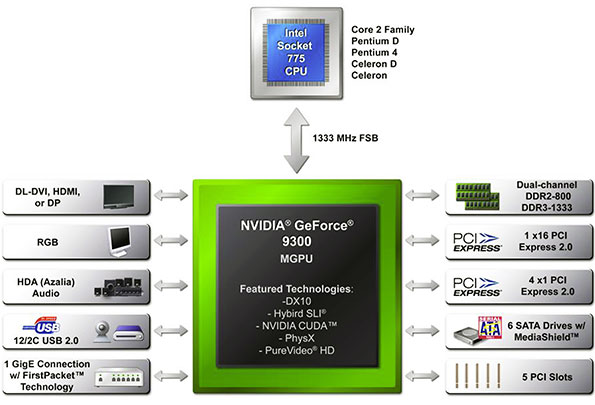NVIDIA GeForce 9300 and 9400 Motherboard GPUs
Introduction and Specifications
With all of the recent hoopla surrounding Intel and NVIDIA as of late, today's announcement may come as a bit of a surprise to many of you. To say that there has been some tension between Intel and NVIDIA lately would certainly be putting it mildly. But the fact of the matter is, for now at least, the two companies share a somewhat symbiotic relationship. The products we'll be showing you here are proof of this fact.

What we have on tap for you today is a new NVIDIA chipset with an mGPU (or IGP) designed for the Intel Socket 775 platform, the GeForce 9300. We should note, however, that NVIDIA is also announcing the GeForce 9400 today as well, the same chipset that powers Apple's new MacBook line of products, but the two are nearly identical save for a few minor spec variations. Whether you're a small form-factor type, Home Theater PC buff or one of the newly enamored by Apple's new line of sleek notebooks, read on to find out about these enabling technologies that NVIDIA has launched today in platform chipsets with integrated graphics engines.
GeForce 9300 Block Diagram
The high-level block diagram above does a good job of clearly illustrating the GeForce 9300's (and 9400's) main features. As you can see, the GeForce 9300 supports virtually all flavors of Core 2, Pentium, and Celeron processors with front side bus speeds up to 1333MHz. The chipset is comprised of a single chip and the mGPU features 16 shader cores, with support for DX10 and many of NVIDIA's proprietary technologies, like CUDA, Hybrid SLI, PhysX and PureVideo HD. The GeForce 9300 mGPU has output support for virtually all of the major port types (DVI, DisplayPort, HDMI, etc.) with support for HD audio as well.
The chipset can support DDR2 or DDR3 memory technologies, although the two motherboards we'll be showing you in this article required DDR2. It also sports 12 USB 2.0 ports, gigabit Ethernet, six SATA 3.0Gb/s ports (with RAID), 20 PCI express 2.0 lanes, and support for 5 PCI slots.
 |
 | |
|
CPU |
Core 2 Family Pentium D Pentium 4 Celeron D Celeron |
Core 2 Family Pentium D Pentium 4 Celeron D Celeron |
|
FSB |
1333 Mhz |
1333 Mhz |
|
Memory Interface |
Dual-channel DDR2-800 / DDR3-1333 |
Dual-channel DDR2-800 / DDR3-1333 |
|
DirectX 10 Support |
Yes |
Yes |
|
Graphics Cores |
16 |
16 |
|
Core/Shader Clocks |
580/1400 MHz |
450/1200 MHz |
|
Texture Fill Rate |
3.6 Billion/second |
3.6 Billion/second |
|
Max. Anti-Aliasing (AA) Sample Rate |
16× |
16× |
|
RAMDACs |
400 MHz |
400 MHz |
|
Max. HDR Precision |
128-bit |
128-bit |
|
Max. Analog Resolution |
2048 × 1536 |
2048 × 1536 |
|
Max Digital Resolution |
2560 × 1600 |
2560 × 1600 |
|
GeForce Boost Technology |
Yes |
Yes |
|
HybridPower Technology |
Only available in select designs |
Only available in select designs |
|
NVIDIA PureVideo HD |
Yes With full HD decode (1080i/p) |
Yes With full HD decode (1080i/p) |
|
Display options |
RGB, dual-link DVI, HDMI, DP |
RGB, dual-link DVI, HDMI, DP |
|
PCI-Express 2.0 |
20 lanes 1 × 16 4 × 1 |
20 lanes 1 × 16 4 × 1 |
|
SATA drives |
6 |
6 |
|
SATA speed |
3 Gbps |
3 Gbps |
|
RAID |
0, 1, 0+1, 5 |
0, 1, 0+1, 5 |
|
NVIDIA MediaShield Storage technology |
Yes |
Yes |
|
Networking |
10/100/1000 |
10/100/1000 |
|
USB ports |
12 / 2C |
12 / 2C |
|
PCI Slots |
5 |
5 |
|
Audio |
HDA (Azalia) |
HDA (Azalia) |
|
HD Audio Support |
7.1 LPCM |
7.1 LPCM |
In terms of their specifications, the new GeForce 9300 and GeForce 9400 are nearly identical. As you can see in the spec list above, the only differences between the two are that the GeForce 9400 has a higher clocked GPU and shader cores. These attribute would obviously give the GeForce 9400 an edge in the 3D performance department, but as you'll see a little later, even the GeForce 9300 is far more powerful than any of Intel's current IGPs.






